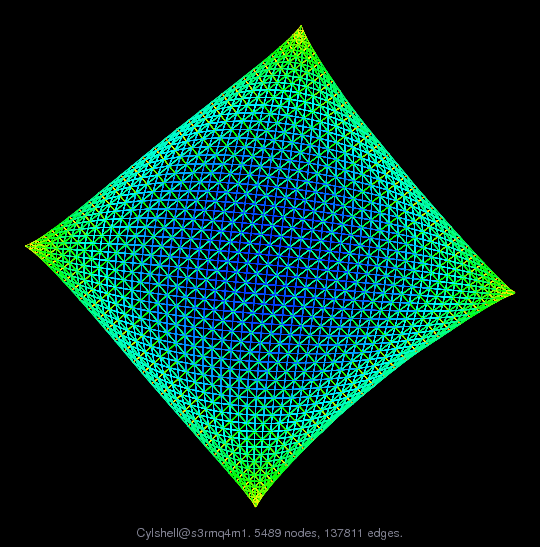
Matrix: Cylshell/s3rmq4m1
Description: FEM, cylindrical shell, 30x30 quad. mesh, stabilized MITC4 elements, R/t=1000
 |
| (undirected graph drawing) |
 |
 |
| Matrix properties | |
| number of rows | 5,489 |
| number of columns | 5,489 |
| nonzeros | 262,943 |
| structural full rank? | yes |
| structural rank | 5,489 |
| # of blocks from dmperm | 1 |
| # strongly connected comp. | 1 |
| explicit zero entries | 18,168 |
| nonzero pattern symmetry | symmetric |
| numeric value symmetry | symmetric |
| type | real |
| structure | symmetric |
| Cholesky candidate? | yes |
| positive definite? | yes |
| author | R. Kouhia |
| editor | R. Boisvert, R. Pozo, K. Remington, B. Miller, R. Lipman, R. Barrett, J. Dongarra |
| date | 1997 |
| kind | structural problem |
| 2D/3D problem? | yes |
| Additional fields | size and type |
| coord | full 5489-by-3 |
Notes:
% %FILE s3rmq4m1.mtx %TITLE Cyl shell R/t=1000 unif 30x30 quad mesh stab MITC4 elem with drill rot %KEY s3rmq4m1 % % %CONTRIBUTOR Reijo Kouhia (reijo.kouhia@hut.fi) % %REFERENCE M. Benzi, R. Kouhia, M.Tuma: An assesment of some % preconditioning techniques in shell problems % Technical Report LA-UR-97-3892, Los Alamos National Laboratory % %BEGIN DESCRIPTION % Matrix from a static analysis of a cylindrical shell % Radius to thickness ratio R/t = 1000 % Length to radius ratio R/L = 1 % One octant discretized with uniform 30 x 30 quadrilateral mesh % element: % facet-type shell element where the bending part is formulated % using the stabilized MITC theory (stabilization paramater 0.4) % the membrane part includes drilling rotations using % the Hughes-Brezzi formulation with (regularizing parameter = G/1000, % where G is the shear modulus) % full 2x2 Gauss-Legendre integration % -------------------------------------------------------------------------- % Note: % The sparsity pattern of the matrix is determined from the element % connectivity data assuming that the element matrix is full. % Since this case the material model is linear isotropically elastic % and the FE mesh is uniform there exist some zeros. % Since the removal of those zero elements is trivial % but the reconstruction of the current sparsity % pattern is impossible from the sparsified structure without any further % knowledge of the element connectivity, the zeros are retained in this file. % --------------------------------------------------------------------------- %END DESCRIPTION % %
| Ordering statistics: | result |
| nnz(chol(P*(A+A'+s*I)*P')) with AMD | 848,498 |
| Cholesky flop count | 1.9e+08 |
| nnz(L+U), no partial pivoting, with AMD | 1,691,507 |
| nnz(V) for QR, upper bound nnz(L) for LU, with COLAMD | 875,592 |
| nnz(R) for QR, upper bound nnz(U) for LU, with COLAMD | 1,734,881 |
Note that all matrix statistics (except nonzero pattern symmetry) exclude the 18168 explicit zero entries.
| SVD-based statistics: | |
| norm(A) | 6874.52 |
| min(svd(A)) | 3.89368e-07 |
| cond(A) | 1.76556e+10 |
| rank(A) | 5,489 |
| sprank(A)-rank(A) | 0 |
| null space dimension | 0 |
| full numerical rank? | yes |
| singular values (MAT file): | click here |
| SVD method used: | s = svd (full (A)) ; |
| status: | ok |

For a description of the statistics displayed above, click here.
Maintained by Tim Davis, last updated 12-Mar-2014.
Matrix pictures by cspy, a MATLAB function in the CSparse package.
Matrix graphs by Yifan Hu, AT&T Labs Visualization Group.